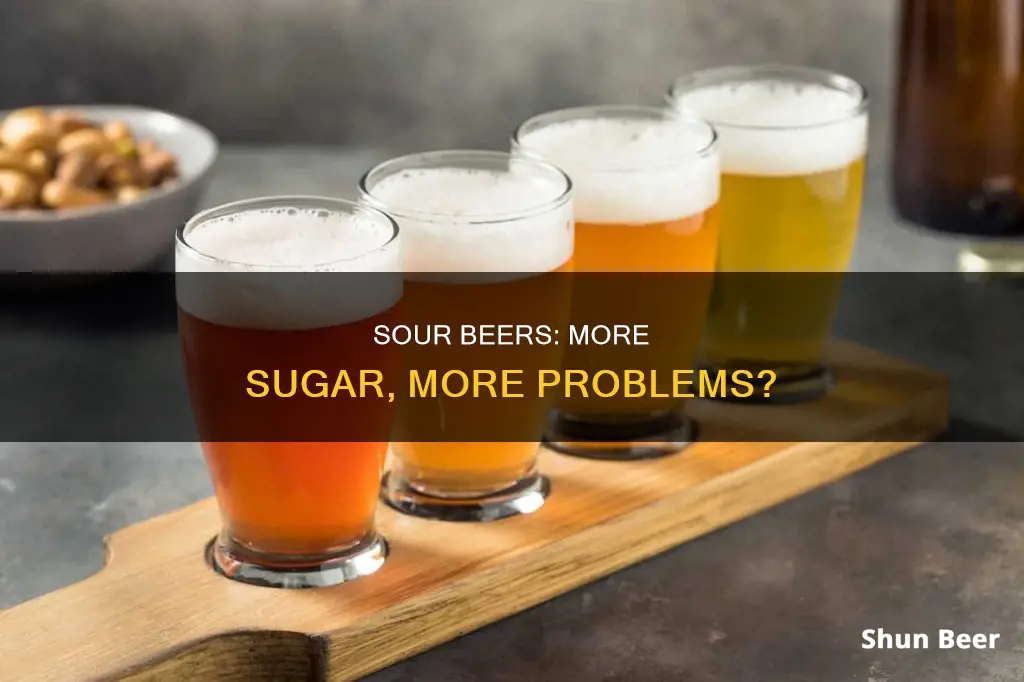
Sour beers have gained popularity in recent years, captivating beer enthusiasts with their unique tart and tangy flavours. But do they have more sugar than other beers?
Sour beers are made using bacteria and wild yeast during the brewing process, which produce lactic acid and other organic acids, resulting in their distinctive sourness. The sugar content in sour beers can vary depending on the brewing process and ingredients used. Generally, sour beers tend to have lower sugar content compared to other beers due to the presence of lactic acid-producing bacteria, which consume the fermentable sugars in the wort. However, some sour beer styles may have higher sugar content due to the addition of fruits, adjuncts, or sweeteners.
While the sugar content in sour beers can vary, it is not the sole determinant of their flavour profile. Other factors such as the type of bacteria and yeast used, the fermentation conditions, and the presence of other ingredients also contribute to the unique flavour characteristics of sour beers.
| Characteristics | Values |
|---|---|
| Taste | Sour, tart or acidic |
| Brewing Process | Uses yeast and bacteria to achieve a bright, tart flavour |
| Fermentation | Involves the fermentation of multiple yeast strains and acid-producing bacteria |
| Yeast | Brettanomyces |
| Bacteria | Lactobacillus and Pediococcus |
| ABV | 3-5% |
| Calories | Low |
What You'll Learn
- Sour beers are made with wild yeast and bacteria, which create a more acidic taste than regular beers
- Sour beers typically have lower sugar content than regular beers due to lactic acid-producing bacteria
- The sugar content in sour beers varies depending on the brewing process and ingredients used
- Sour beers are generally lower in sugar than regular beers, but some sour styles may have higher sugar content
- Sour beers are not necessarily higher in sugar than regular beers, but certain factors can increase sugar levels

Sour beers are made with wild yeast and bacteria, which create a more acidic taste than regular beers
Sour beers are made using a unique brewing process that involves wild yeast and bacteria, creating a more acidic taste than regular beers. This style of beer has become increasingly popular among seasoned beer drinkers, novices, and even non-beer drinkers due to its distinctively sour flavour.
The sour taste of these beers is achieved by using wild yeast strains and acid-producing bacteria such as lactobacillus and pediococcus during the brewing process. These bacteria consume the fermentable sugars present in the wort, resulting in lower residual sugar content in the final beer. The wild organisms used can bring a wide range of flavours, from intensely sour to light and fruity to downright funky.
The brewing process for sour beer typically involves five steps:
- The grain is mashed with malt and water, then rinsed to extract as much sugar as possible without removing grain husks (sparging).
- A small amount of aged hops is added to the boil to prevent inhibiting bacterial growth.
- The mixture is transferred to a secondary fermentation vessel, where yeast and bacteria are added.
- The beer starts to ferment, forming a head of foamy yeast and wort proteins that bubble on the surface.
- The fermentation process is completed, which can take several months until the desired level of lactic acid concentration and sourness is reached.
Sour beers typically have an alcohol content between 3-5%, but some may be as low as 2% or as high as 8-9%, depending on the style and brewing conditions.
The sugar content in sour beers can vary depending on the brewing process and ingredients used. Generally, sour beers have lower sugar content due to the presence of lactic acid-producing bacteria. However, some sour beer styles may have higher sugar content if they include added fruits or adjuncts, such as fruit lambics and fruited Berliner Weisse.
Best Sugar-Free Beers: Enjoy Guilt-Free Sipping
You may want to see also

Sour beers typically have lower sugar content than regular beers due to lactic acid-producing bacteria
Sour beers are characterised by their tart, acidic taste, which is achieved through the use of bacteria and wild yeast during the brewing process. These microorganisms produce lactic acid and other organic acids, resulting in a more acidic taste than regular beers.
The sugar content in sour beers is typically lower than that of regular beers due to the presence of lactic acid-producing bacteria. These bacteria consume the fermentable sugars in the wort, leading to a reduced sugar content in the final product. The specific type of malt and mashing techniques, yeast strains, fermentation conditions, and addition of fruits or other ingredients can all influence the sugar levels in sour beers.
The process of making sour beer involves mashing the grain with malt and water, then rinsing the grain bed to extract as much sugar as possible without removing tannins from the grain husks. This process, known as sparging, is followed by the addition of a small amount of aged hops to the boil. The bacteria is then added after the mixture has cooled, and the beer is transferred to a secondary fermentation vessel to be primed with yeast and bacteria.
The fermentation process can take several months, or until the desired level of lactic acid concentration and sourness is achieved. The wild organisms used in this process contribute to a wide range of flavours, from intensely sour to light and fruity.
Beer Sugar Content: Is It Really That High?
You may want to see also

The sugar content in sour beers varies depending on the brewing process and ingredients used
The sugar content in sour beers can vary depending on the brewing process and ingredients used. While some sour beers may have lower sugar content than other beer styles, this is not always the case. The presence of lactic acid-producing bacteria, such as lactobacillus and pediococcus, is a key factor in determining the sugar level of sour beers. These bacteria consume the fermentable sugars in the wort, resulting in a lower residual sugar content in the final beer.
The choice of malt and mashing techniques can also impact the amount of fermentable sugars available for the bacteria and yeast to consume, thereby affecting the final sugar content. Additionally, the selection of yeast strains and fermentation conditions, such as temperature and duration, can influence the rate and extent of sugar fermentation.
Some sour beer styles that typically have higher sugar content include fruit lambics, fruited Berliner Weisse, and Flanders Red Ales. These styles often incorporate fruits, adjuncts, or sweeteners during the brewing process, contributing to a higher overall sugar content.
It is important to note that the sugar content is just one factor influencing the overall flavor profile of sour beers. The type of bacteria and yeast used, the fermentation conditions, and the presence of other ingredients also play significant roles in shaping the unique flavor characteristics of these beers.
When it comes to health considerations, the sugar content in sour beers can impact calorie intake and alcohol content. Therefore, moderate and responsible consumption is recommended for individuals monitoring their sugar and alcohol intake.
Beer and Blood Sugar: A Dangerous Mix?
You may want to see also

Sour beers are generally lower in sugar than regular beers, but some sour styles may have higher sugar content
Sour beers get their distinctive tart and tangy flavour from the use of bacteria and wild yeast during the brewing process, which produce lactic acid and other organic acids. These microorganisms consume the fermentable sugars present in the wort, resulting in a lower residual sugar content in the final beer. However, certain factors can influence the sugar levels in sour beers, such as the choice of malt and mashing techniques, the type of yeast and fermentation conditions, and the addition of fruits or other adjuncts.
For example, some sour beer styles that may have higher sugar content include fruit lambics, fruited Berliner Weisse, and Flanders Red Ales, which often have added sugars during the brewing process. On the other hand, sour beers that emphasise lactic acid production, such as Lambic, Berliner Weisse, and Flanders Red Ale, tend to have lower residual sugar content.
It is important to note that the sugar content is not the sole determinant of the overall flavour profile of sour beers. Other factors, such as the specific bacteria and yeast used, fermentation conditions, and the presence of other ingredients, also play a significant role in shaping the unique flavour characteristics of sour beers.
When it comes to health considerations, the sugar content in sour beers can impact calorie intake and alcohol content. Therefore, it is always recommended to consume sour beers in moderation and be mindful of one's sugar and alcohol consumption.
Sugar Secrets: Priming Beer with Precise Sugar Grams
You may want to see also

Sour beers are not necessarily higher in sugar than regular beers, but certain factors can increase sugar levels
Sour beers are characterised by their tart, acidic taste, which is achieved through the use of bacteria and wild yeast during the brewing process. These microorganisms produce lactic acid and other organic acids, resulting in a more acidic taste than regular beers. The presence of lactic acid-producing bacteria, such as Lactobacillus and Pediococcus, can lead to lower sugar content in sour beers compared to other styles. These bacteria consume the fermentable sugars in the wort, resulting in a lower residual sugar content in the final beer.
However, several factors can influence the sugar levels in sour beers. The choice of malt and mashing techniques can impact the amount of fermentable sugars available for the bacteria and yeast to consume. Additionally, the selection of yeast strains and fermentation conditions, such as temperature and duration, can affect the rate and extent of sugar fermentation.
Furthermore, some sour beer styles incorporate fruits, adjuncts, or sweeteners during the brewing process, which can contribute additional sugars. For example, Flanders Red Ale, a Belgian sour beer, often has a higher sugar content due to the addition of caramelised sugars. Lambics, a Belgian sour beer, typically contain between 5 and 10 grams of sugar per 12-ounce serving, while Berliner Weisse, a German sour beer, usually has between 5 and 15 grams of sugar per serving.
While the sugar content in sour beers can vary, it is important to note that sugar is not the sole determinant of their flavour profile. Other factors, such as the type of bacteria and yeast used, fermentation conditions, and the presence of other ingredients, also play significant roles in shaping the unique flavour characteristics of sour beers.
In conclusion, while sour beers may have varying sugar levels depending on brewing techniques and ingredients, certain factors can increase the sugar content. However, it is important to consider the interplay of multiple factors when understanding the overall flavour profile of sour beers.
Coke vs Beer: Which Drink Contains More Sugar?
You may want to see also
Frequently asked questions
Sour beers tend to have lower sugar content than regular beers due to the presence of lactic acid-producing bacteria. However, some sour beers may contain added sugars, depending on the brewing techniques and ingredients used.
Several factors can impact the sugar levels in sour beers, including the choice of malt and mashing techniques, yeast strains and fermentation conditions, and the addition of fruits or sweeteners.
Sour beer styles with added fruits, such as fruit lambics and fruited Berliner Weisse, tend to have higher sugar content. Flanders Red Ales, a Belgian sour beer, also often have higher sugar content due to the addition of caramelized sugars.
While higher sugar content can contribute to a sweeter taste, the overall flavour profile of sour beers is determined by a balance between sweetness and sourness, as well as other factors such as the type of bacteria and yeast used, fermentation conditions, and the presence of other ingredients.







